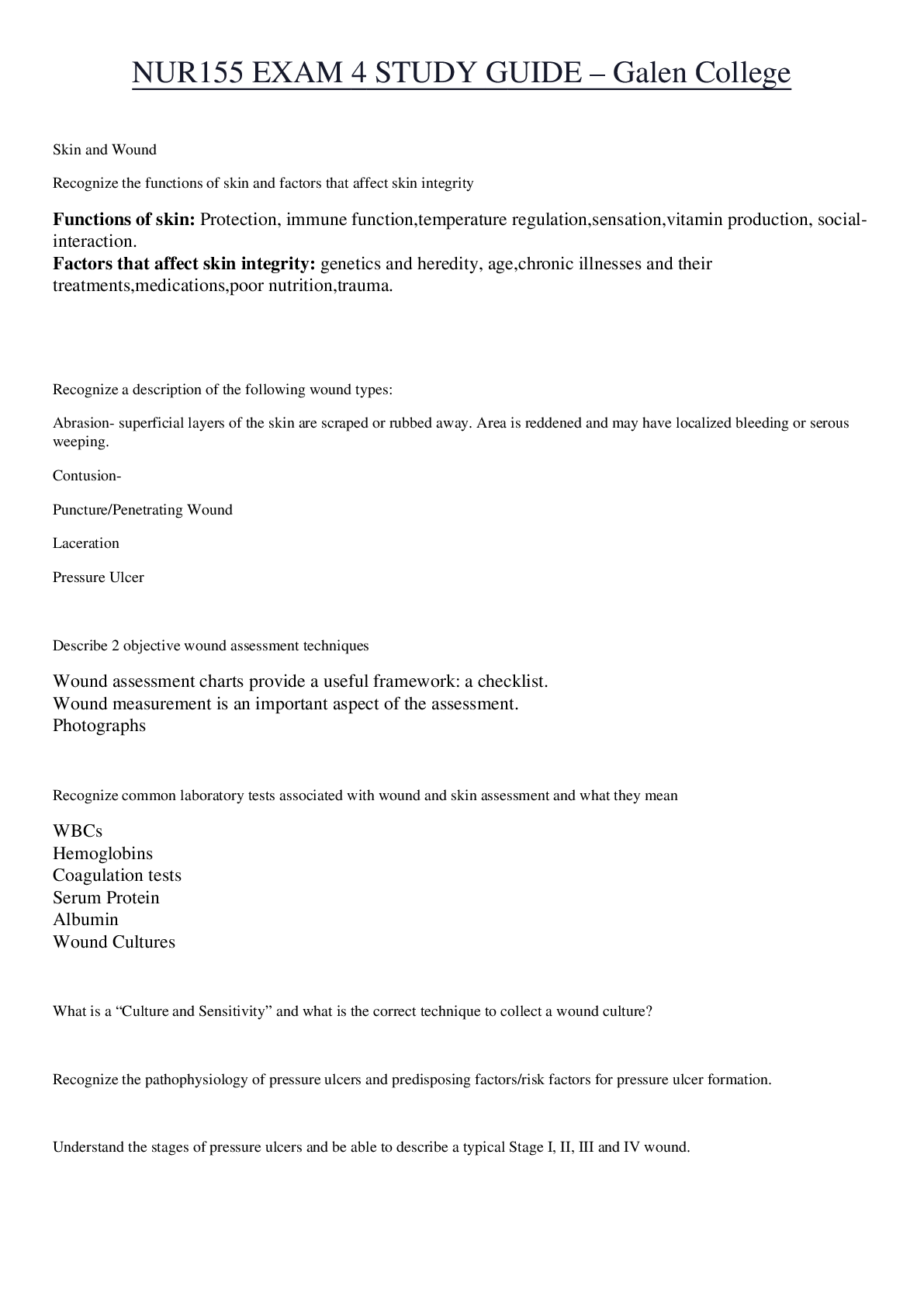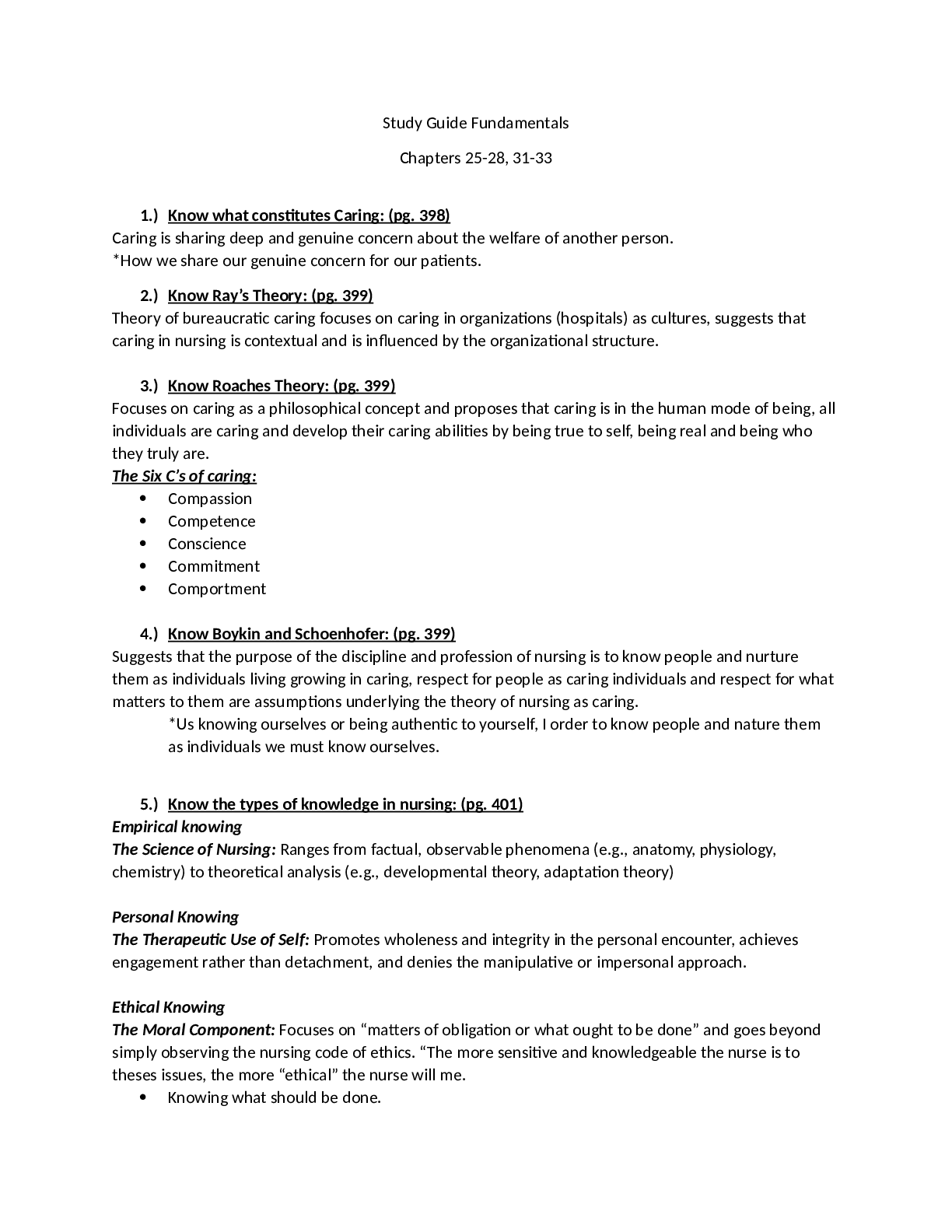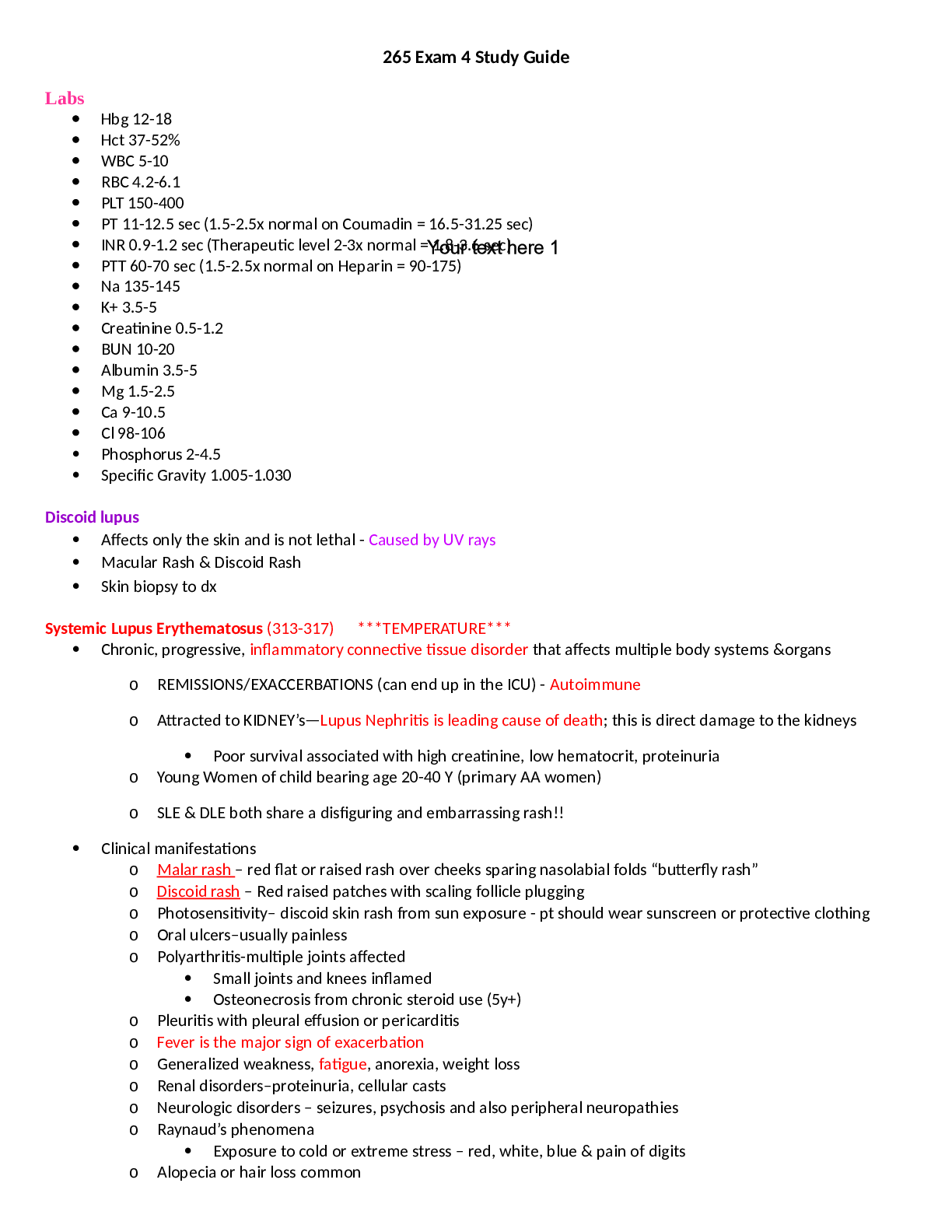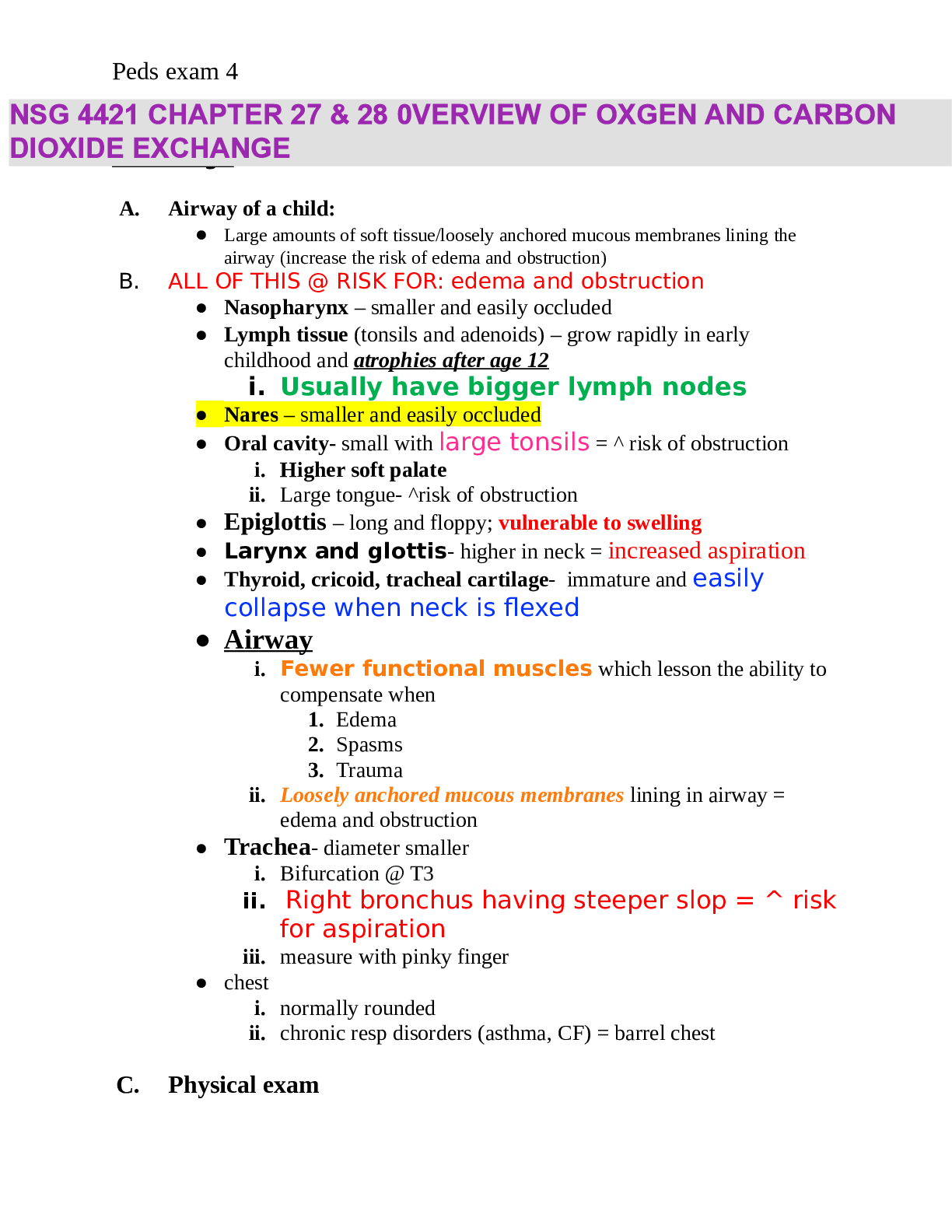*NURSING > STUDY GUIDE > NURS 611 Exam 4 Study Guide (Week 15 Renal and Urologic Systems: Chapters 38 & 39) (All)
NURS 611 Exam 4 Study Guide (Week 15 Renal and Urologic Systems: Chapters 38 & 39)
Document Content and Description Below
Week 15 Renal and Urologic Systems: Chapters 38 & 39 Urinary Tract Obstruction: interference with the flow of urine at any site along the urinary tract * Impedes urine flow, increases hydrostati... c pressure, and dilates structures proximal to the obstruction, increases risk for infection, and compromises renal function Acute Unilateral Renal Obstruction & Hypertension * Passage of kidney stones can be extremely painful & may produce “referred pain” to umbilicus area (due to the sensory innervation of the upper part of the ureter arising from the 10th thoracic nerve roots) Reduced perfusion (kidneys requirement is at least 20-25% CO-MAP) of the affected kidney activates the RAAS, which causes constriction of peripheral arterioles (= HTN) Kidney Stones: masses of crystal, protein, or other substances that are a common cause of urinary tract obstruction * Risk factors are age, sex, race, geographic location, seasonal factors, fluid intake, diet, occupation, genetics, other conditions such as UTI, HTN, atherosclerosis, metabolic syndrome, obesity and DM type II * Classified according to primary minerals that make up the stones--> Calcium Oxalate most common Pathophysiology Complex process; involves (1) supersaturation of one or more salts in urine, (2) precipitation of salts from a liquid to a solid state, (3) growth through crystallization or agglormeration, and (4) effect of stone inhibitors Clinical Manifestations—Pain, N/V, Gross or microscopic hematuria * Renal colic is moderate to severe pain Posterior flank & radiates to groin Renal pelvis or proximal ureter Lateral flank or lower abdomen Midureter Bothersome UTI symptoms (urgency, frequent voiding, urge incontinence) Lower ureter or uterovesical junction Urinary Tract Infections (UTI) * Inflammation of the urinary epithelium usually caused by bacteria from gut flora, occurs anywhere along the urinary tract (urethra, bladder, ureter, or kidney) Who is at risk? Premature newborns; prepubertal children; sexually active and pregnant women; women treated with antibiotics that disrupt vaginal flora; spermicide users; estrogen-deficient postmenopausal women; individuals with indwelling catheters; persons with DM, neurogenic bladder, or urinary tract obstruction Clinical manifestations of a UTI in an older adult are confusion and poorly localized abdominal discomfort, very difficult diagnose due to vague symptoms Types I. Cystitis * Inflammation of the bladder & the most common site of UTI Pathophysiology—most common infecting microbe is E.coli (80-85%), second is Staphylococcus saprophyticus (10%). Bacterial contamination of the sterile urine usually occurs by retrograde movement of uropathic gram-negative bacilli from the gut into the urethra and bladder and then to the ureter and kidney Clinical Manifestations: related to the host inflammatory response & usually include frequency, urgency, dysuria (painful urination), & suprapubic and low back pain › Inflammatory edema in the bladder wall stimulates discharge of stretch receptors, initiating symptoms of bladder fullness with small volumes of urine & producing urgency and frequency › Hematuria, flank pain, cloudy & foul-smelling urine are most serious symptoms Treatment--> urosepsis & septic shock are medical emergencies, demand parenteral, broad-spectrum antibx tx and may require hospitalization II. Pyelonephritis * Infection of one or both upper urinary tracts (ureter, renal pelvis, kidney interstitium) Urinary obstruction & reflux of urine from the bladder (vasicoureter reflux) are the most common underlying risk factors Common causes are kidney stones, vesicoureteral reflux, pregnancy, neurogenic bladder, instrumentation, and female sexual trauma Pathophysiology— Microbes associated include E.coli, Proteus, & Pseudomonas. Latter two are associated with infections after surgery. These specific microbes split urea in to ammonia, making alkaline urine that increases the risk of stone formation. In severe infections, localized abscesses may form in the medulla and extend to the cortex. Clinical Manifestations: acute, with fever, chills, and flank or groin pain. Older adults may experience low-grade fever and malaise. ** Differentiating symptoms of cystitis from those of pyelonephritis by clinical assessment alone is difficult. The specific diagnosis is established by urine culture, UA, and clinical signs & symptoms. WBC casts indicate pylenephritis** Painful Bladder Syndrome/Interstitial Cystitis (PBS/IC): unpleasant sensation (pain, pressure, discomfort) perceived to be related to the urinary bladder associated with lower urinary tract symptoms of more than 6 weeks’ duration in the absence of infection or other identifiable causes * Includes nonbacterial infectious cystitis (viral, mycobacterial, chlamydial, fungal) and noninfectious cystitis (radiation, chemical, autoimmune, hypersensitivity) * Cause is UNKNOWN, but an autoimmune reaction may be responsible for the inflammatory response Characteristic symptoms of IC include bladder fullness, frequency (nocturia), small urine volume, and chronic pelvic pain with symptoms lasting more than 6 months Glomerular Disorders Diseases affect kidney function by attacking the glomeruli (tiny units within the kidney where blood is cleaned), significant cause of CKD and ESRD These diseases include many conditions with a variety of genetic and environmental causes, but they fall into two main categories: glomerulonephritis & glomerulosclerosis Reduced GFR during glomerular disease is evidenced by elevated plasma urea, creatinine concentration, or reduced renal creatinine clearance Acute Glomerulonephritis: inflammation of the glomerulus caused by immune mechanisms that damage the glomerular capillary filtration membrane including the endothelium, basement membrane, and epithelium (podocytes) * Secondary glomerular injury is a consequence of systemic diseases, including DM, SLE, and, less commonly, CHF and HIV-related kidney disease Pathophysiology—Immune mechanisms Deposition of circulating antigen-antibody immune complexes (type III), (2) reaction of antibodies in situ against planted antigens within the glomerulus (type II), (3) action of antibodies directed against the glomerular [Show More]
Last updated: 2 years ago
Preview 1 out of 31 pages

Buy this document to get the full access instantly
Instant Download Access after purchase
Buy NowInstant download
We Accept:

Also available in bundle (1)

NURS 611 Exam 1 - Exam 4 Study Guides. ALL A+ RATED
NURS 611 Exam 1 - Exam 4 Study Guides. ALL A+ RATED
By Quality Suppliers 4 years ago
$30.5
4
Reviews( 0 )
$15.00
Can't find what you want? Try our AI powered Search
Document information
Connected school, study & course
About the document
Uploaded On
Mar 07, 2021
Number of pages
31
Written in
Additional information
This document has been written for:
Uploaded
Mar 07, 2021
Downloads
0
Views
97





















.png)




